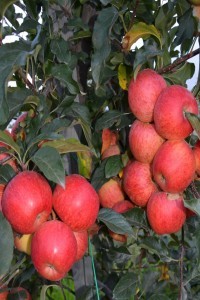Xenia and metaxenia affects bioactive compounds of hazelnut
Xenia and metaxenia affects bioactive compounds of hazelnut
The study aimed to assess the effects of pollinator cultivars on the bioactive compounds of hazelnut cultivars. ‘Tombul’, ‘Palaz’, ‘Çakıldak’, ‘Foşa’ and ‘Allahverdi’ were used as the main cultivars and ‘Sivri’, ‘Kalınkara’ and ‘Yassı Badem’ were used as the pollinators. Self-pollination was accepted as control. It was determined that pollinator cultivars resulted in significant changes in oil and protein ratios and fatty acid composition of hazelnut cultivars mostly because of xenia and metaxenia effects. Protein content and oil content changed depending on pollinator cultivar. The oleic acid was the dominant fatty acid in all hazelnut cultivars
Keywords:
Corylus avellana, fatty acid composition, Pollinator Oil, Protein,
___
- Anonymous, (2018a). Food and Agriculture Organization of the United Nations. http://www.fao.org/faostat/en/#data/QC (Date of access: 31.01.2018).
- Anonymous, (2018b). Hazelnut Research Institute Web Page.https://arastirma.tarim.gov.tr/findik/Sayfalar/Detay.aspx?SayfaId=29 (Date of access: 31.01.2018).
- Ayfer, M., Uzun, A. & Baş, F. (1986). Türk Fındık Çeşitleri. Karadeniz Bölgesi Fındık ve Mamulleri İhracatçılar Birliği Yayınları, 95, Ankara, Turkey.
- Balik, H.I., Kayalak Balık, S., Beyhan, N. & Erdoğan, V. (2016). Fındık Çeşitleri (Hazelnut Cultivars). Klasmat Matbaacılık, 96, Trabzon, Türkiye.
- Balik, H.I, Beyhan, N. (2019). Pollen compatibility in Turkish hazelnut cultivar. Turkish Journal of Food and Agriculture Sciences, 1: 12-17.
- Baysal, A. (1993). Genel Beslenme (8. Baskı), Hatipoğlu Kitabevi, 194, Ankara.
- Beyhan, N. (2000). Fındığın Döllenme Biyolojisi. Ondokuzmayıs Üniversitesi Ziraat Fakültesi Dergisi, 15:2, 116-122.
- Bonvehi, J. S. & Cool, F. V. (1993). Oil content, stability and fatty acid composition of the main varieties of Catalonian hazelnuts (Corylus avellana L.). Food Chemistry, 48:3, 237-241.
- Botta, R., Gianotti, C., Richardson, D.G., Suwanagul, A. & Sanz, C.L. (1994). Hazelnut variety organic acids sugars and total lipid fatty acids. Acta Horticulturae, 445: 319-326.
- Denney, J.O. (1992). Xenia includes metaxenia. Hortscience, 27:7, 722-728.
- Dicenta, F., Martinez-Gomez, P., Ortega, E. & Duval, H. (2000). Cultivar pollinizer does not affect almond flavor. Hortscience, 35: 1153-1154.
- Dure, L.S. (1975). Seed formation. Annual Reviews, Plant Physiology, 26: 259-278.
- Erdogan, V. & Mehlenbacher, S.A. (1997). Preliminary results on interspesific hybridization in Corylus. IV. International Symposium on Hazelnut. 1 May 1997, ISHS Acta Horticulturae 445, 65-71, Ordu, Turkey.
- Fatahi, R., Mohammadzedeh, M., & Khadivi-Khub, A. (2014). Influence of different pollen sources on nut and kernel characteristics of hazelnut. Scientia Horticulturae, 173: 15-19.
- Focke, W.O. (1881). Die Pflanzen-Mischlinge:ein Beitrag zur Biologie der Gewachse. Bomtrae-ger, 510-518, Berlin.
- Garcia, J.M., Ağar, İ.T., & Streif, J. (1994). Lipid characteristics of kernels from different hazelnut varieties. Turkish Journal of Agriculture and Forestry. 18: 199-202.
- Golzari, M., Hassani, D., Rahemi, M., & Vahdati, K. (2016). Xenia and metaxenia in Persian walnut (Juglans regia L.). Journal of Nuts 7:2, 101-108.
- Göncüoğlu Taş, N., & Gökmen, V. (2015). Bioactive compounds in different hazelnut varieties and their skins, Journal of Food Composition and Analysis. 43: 203–208.
- Kayahan, M. (1981). Beslenme ve insan sağlığı açısından bitkisel yağların önemi. Gıda, 6: 5, 23-30.
- Kester, D.E., Cunningham, S., & Kader, A.A. (1993). Almonds. Encyclopedia of foodscience, food technology and nutrition. Academic Press, 121-126. London.
- Kirkpatrick, E.M. (editor) (1987). Chambers 20th century dictionary. New ed. Chambers, Edinburgh.
- Kodad, O. & Company, R.S. (2008). Fruit quality in almond as related to the type of pollination in self-compatible genotypes. Journal of American Society Horticultural Science, 133:3, 320-326.
- Koyuncu, M.A., İslam, A. & Küçük, M. (2005). Fat and fatty acid composition of hazelnut kernels in vacuum packages during storage. Grasas Aceites, 56:4, 263-266.
- Köksal, A.İ. (2002). Türk Fındık Çeşitleri. Fındık Tanıtım Grubu, 136, Ankara.
- Mehlenbacher, S.A. (2014). Geographic distribution of incompatibility alleles in cultivars and selections of European hazelnut. Journal of the American Society for Horticultural Sciences, 139:2, 191-212.
- Morris, W. (editor) (1976). The American Heritage Dictionary of the English Language. Hough Mifflin, Boston.
- Navaschin, S. (1898). Resultat einer Revision des Befruhtusvorganger bei Lillium martagon und Fritillaria tenella Bul. de Academia Imp. de St.Petersbourg, 9:1-6.
- Neufeldt, V. (editor) (1988). Webster’s New World dictionary of American English. 3rd College ed. Webster’s New World, New York.
- Okay, A.N., Çalışkan, T. & Çakırmelikoğlu, C. (1999). Fındık Genetik Kaynakları Projesi ‘Allahverdi’ Fındık Çeşidinin Tanımlanması. Sonuç Raporu, Fındık Araştırma Enstitüsü.
- Özenç, N., Özenç, D.B. & Duyar, Ö. (2015). Nutritional composition of hazelnut (Corylus avellana L.) as influenced by basic fertilization. Acta Agriculturae Scandinavica, Section B-Soil- Plant Science, 64:8, 710-721.
- Pala, M., Açkurt, F., Löker, M., Yıldız, M. & Ömeroğlu, S. (1996). Fındık çeşitlerinin bileşimi ve beslenme fizyolojisi bakımından değerlendirilmesi. Turkish Journal of Agriculture and Forestry, 20: 43-48.
- Reiger, R., Michaelis, A. & Green, M.M. (editor) (1976). Glossary of genetics and cytogenetics, classical and molecular. 4th ed. Springer-Verlag, Berlin.
- Saura Calixto, F.J., Canelles Mut, J. & Soler, L. (1988). La almendra: Composicion, variedades, desarrollo y maduracion. Instituyo Nacional de Investigaciones Agrarias, Spain.
- Soule, J. (1985). Glossary for horticultural crops. Wiley, New York.
- Strasburger, E. (1878). Uber polyembryonie. Zeitschr. für Naturwiss, 12: 654-678.
- Swingle, W.T. (1928). Metaxenia in the date palm, possibly o hormone action by the embryo or endosperm, Journal of Heredity, 19: 257-268.
- Şimşek, A. & Aslantaş, R. (1999). Fındığın bileşimi ve insan beslenmesi açısından önemi. Gıda, 24: 3, 209-216.
- Vezvaei, A. & Jackson, J.F. (1995). Effect of pollen parent and stages of flower development on almond nut production. Australian Journal of Experimental Agriculture, 35: 109-113.
- Vezvaei, A., & Jackson, J.F. (1996). Almond nut analysis. In: H.F. Linsken, J.F. Jackson (editors). Modern methods of plant analysis. Fruit analysis. 18, Springer-Verlag, Berlin.
- Westwood, M.N. (1989). Temperate-zone pomology. W.H. Freeman, 373-376, New York.
- Winburne, J.N. (1962). A dictionary of agricultural and allied terminology. Michigan State University Press, East Lansing, Michigan.
- Xuhui, Z., Deyi, Y., Feng, Z., Xiaoming, F., Jing, T. & Zhoujun, Z. (2016). A study on the xenia effect in Castanea henryi. Horticultural Plant Journal, 2:86, 301-308.
- Yayın Aralığı: Yılda 2 Sayı
- Başlangıç: 2019
- Yayıncı: Burhan ÖZTÜRK
